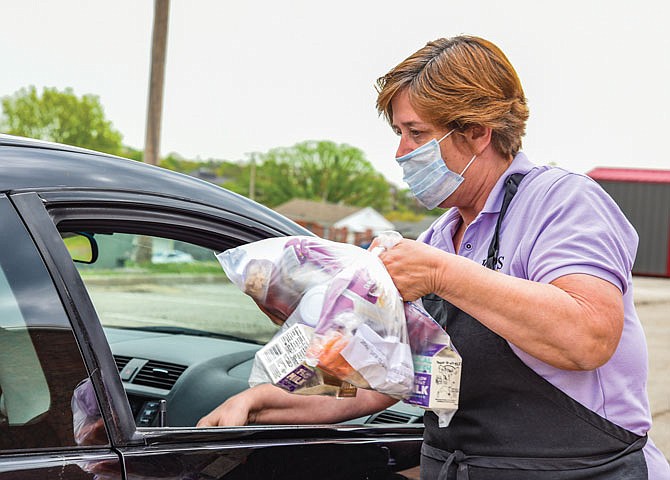[<a href="https://www.newstribune.com/news/health/" style="color:#33AEFF">access the News Tribune Health section</a>]
Overall in 2018, the health of Missouri's children improved over the previous year, according to the recently released 2020 Missouri KIDS COUNT report.
The report collects data from each of the state's 114 counties and the city of St. Louis to create an annual snapshot on the well-being of Missouri's children. It comes as the state is hunkered down to prevent the spread of COVID-19.
The report, first released in 1993, shows year-over-year there had been generally positive trajectory for children's health in the state, according to Tracy Greever-Rice, Missouri KIDS COUNT program director.
The data are intended to measure the physical well-being of children based on economic well-being, health, family and community, and education. The latest data look at changes from 2014-18.
The report could serve as a baseline for tracking the long-term effects of the current pandemic and policies that go in place in response to it, according to Missouri KIDS COUNT.
Like the anticipated spread of COVID-19, Missouri KIDS COUNT expects the pandemic to affect children in waves, she said. Social distancing and stay-at-home orders will have economic impacts on the state's families for a long time to come.
Overall, some indicators of physical well-being improved from 2014, including preventable hospitalizations and child deaths between the ages of 1-14. However, the number of low-birth-weight infants increased, as did death rates for adolescents (children ages 15-17) - attributed to an increase in suicides.
"The number of young people under age 20 who committed suicide doubled during this five-year period," Greever-Rice said. "We are concerned that this growing problem will be exacerbated by the economic impact on job and educational opportunities created by the COVID-19 crisis."
Data for the most recent period show the death rate for adolescents in Cole County more than doubled. It also showed hospitalizations for children nearly doubled during the latest period. Substance abuse hospitalizations for children spiked from 12.6 per 100,000 population to 31.7.
While most counties showed general health improvement, rural areas - such as the counties containing and surrounding the Mark Twain Forest and many counties in the Bootheel - continue to rank among the unhealthiest.
Osage County remained first-ranked for the health of its children. The city of St. Louis remained 115th-ranked.
Cole County held steady, ranked 53rd for the health outcomes of its children. In terms of economic well-being, the county improved in both measures - children under 18 in poverty (dropped from 18 percent to 12 percent) and food insecurity for children (from 19.8 percent to 16.1 percent). Among counties in the state, Cole was within the top 15 for the measures.
Under outcome measures for health, the county didn't fare as well. It increased in the percentage of children born with low birth weights (from 8.2 percent in 2014 to 8.7 percent in 2018).
Cole County made improvements for preventable hospitalizations for children under 18 (from 8.6 per 1,000 children to 6.7 per 1,000) and child asthma emergency room rates (from 7.7 per 1,000 to 7.6 per 1,000). But it ranked in the lower half of the state's counties for each of the health outcomes and was ranked 108th for child asthma emergency room rates.
Among the state's counties, Cole was highly ranked within family and community measures - births to teenagers ages 15-19 and substantiated child abuse/neglect cases. Births to teenagers decreased from 20.7 per 1,000 to 18.2 per 1,000 (ranking the county 26th in the state). Substantiated abuse cases ticked up slightly from 1.5 per 1,000 to 1.6 per 1,000 (ranking the county seventh in Missouri).
As for education, although Cole County's graduation rate increased from 86.7 percent to 87.4 percent, it remained ranked 107th in Missouri. The statewide graduation rate is 91.3 percent.
Osage County is second-ranked in food insecurity for children. Only 13.5 percent of children experienced food insecurity, while the state rate was 17.5 percent. It was fourth-ranked for children in poverty within Missouri, at 10.1 percent.
Although it had improvements overall, Callaway County sank in state rankings from 67th to 85th. That was in part because of increases in teen births (from 21.7 per 1,000 to 22.7) and substantiated child abuse/neglect cases (from 6.9 per 1,000 to 9.3).
And although the county increased its high school graduation rate from 85.4 percent to 90.2 percent, it remained below the state average of 91.3 percent. Callaway County ranked 92nd in the state in graduation rate.
Other areas where the overall state improved were in preventable hospitalizations for children under 18 (3.5 per 1,000) and child asthma rates (2.2 per 1,000 emergency room visits).
It will be several years before we get a clear picture of what effect the pandemic has on children's health in Missouri, Greever-Rice said.
Local, state and federal agencies are "aggressively changing policies" right now to contend with the virus.
"Across the world, it is going to take a little bit for data to accumulate - to understand what has happened during this period," she said.
Researchers anticipate a lot of work to make sure their trend lines are accurate - as they look at how policies affect communities.
"We want people to be better - that's the important thing," Greever-Rice said. "As we look at the impact of COVID 19, there will be a lot of follow-up work."

